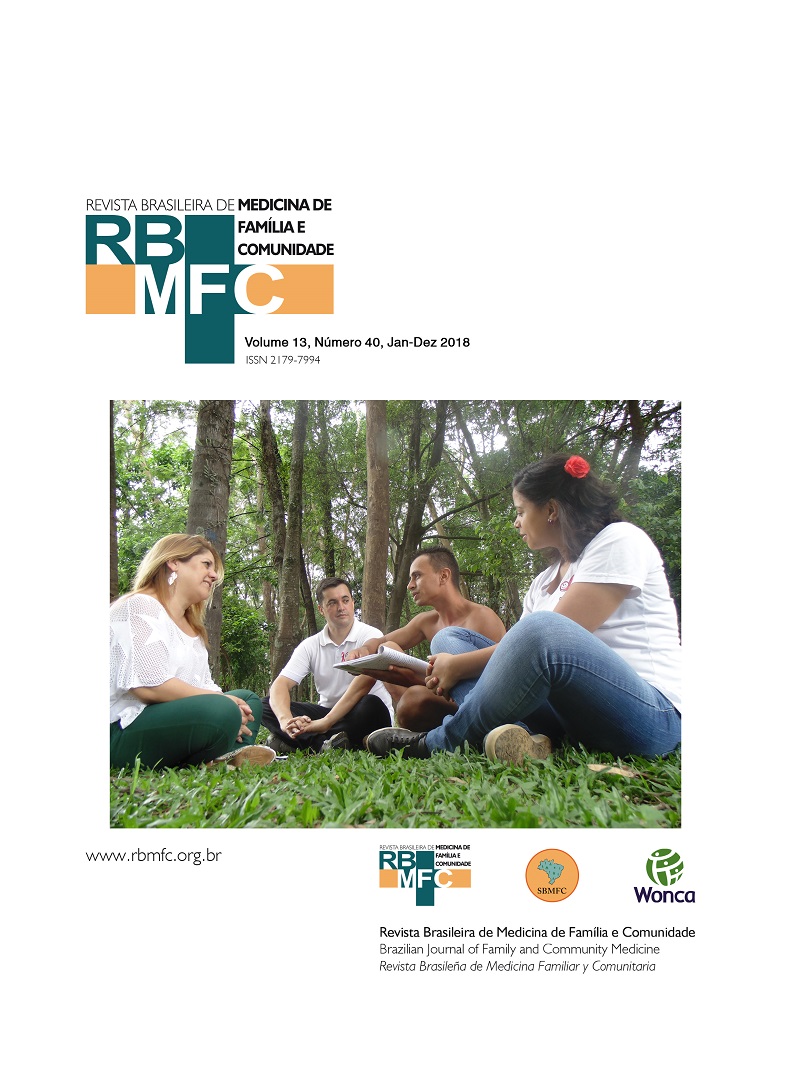Specific mental disorder screening compilation may detect general mental disorders
DOI:
https://doi.org/10.5712/rbmfc13(40)1685Keywords:
Mental Disorders, Primary Health Care, Mass Screening, Reproducibility of Results, Validity of Tests.Abstract
Objective: To evaluate whether a short compilation of screening tools for specific disorders could identify Mental or Emotional Disorders (MEDs) in the general population. Methods: We selected validated screening tools for the most prevalent MEDs. In order to be selected, these tools should maintain the psychometric properties of the complete instrument with a reduced number of items. These instruments were: Patient Health Questionnaire-2 (PHQ-2), Generalized Anxiety Disorder Scale-2 (GAD-2), item 3 of the Alcohol Use Disorders Identification Test (AUDIT), and three items on the Adolescent Psychotic-Like Symptom Screener (APSS-3). We called this compilation of screening tools Mini Screening for Mental Disorders (Mini-SMD). The study was divided in two phases. Firstly, 545 subjects were interviewed with the Mini-SMD and COOP/WONCA-Feelings at their residences. Subsequently, subjects who had agreed to participate (230) were reinterviewed with Mini-SMD, COOP/WONCA-Feelings and MINI interview. Test-retest reliability was calculated by Intraclass Correlation Coefficient (ICC). Receiver operating characteristic (ROC) curves were generated for the analysis of discriminative validity. Concurrent validity was calculated by analyzing the correlation between Mini-SMD and COOP/WONCA-Feelings. Results: The joint administration of screening tools for specific disorders showed sensitivities that ranged from 0.76 to 0.88 and specificities from 0.67 to 0.85. The ICC value for the total score of Mini-SMD was 0.78. The area under the curve was 0.84, with a sensitivity of 0.74 and specificity of 0.76 (for a cutoff ≥ 4). Conclusion: This study showed that a short compilation of screening tools for specific disorders can detect MEDs in general population.
Downloads
Metrics
References
Cross-national comparisons of the prevalences and correlates of mental disorders. WHO International Consortium in Psychiatric Epidemiology. Bull World Health Organ. 2000;78(4):413-26.
Fernández A, Haro JM, Martinez-Alonso M, Demyttenaere K, Brugha TS, Autonell J, et al. Treatment adequacy for anxiety and depressive disorders in six European countries. Br J Psychiatry. 2007;190:172-3. DOI: http://dx.doi.org/10.1192/bjp.bp.106.023507 DOI: https://doi.org/10.1192/bjp.bp.106.023507
Mulvaney-Day N, Marshall T, Downey Piscopo K, Korsen N, Lynch S, Karnell LH, et al. Screening for Behavioral Health Conditions in Primary Care Settings: A Systematic Review of the Literature. J Gen Intern Med. 2017;25:1-12.
Gonçalves DA, Fortes S, Campos M, Ballester D, Portugal FB, Tófoli LF, et al. Evaluation of a mental health training intervention for multidisciplinary teams in primary care in Brazil: a pre- and posttest study. Gen Hosp Psychiatry. 2013;35(3):304-8. DOI: http://dx.doi.org/10.1016/j.genhosppsych.2013.01.003 DOI: https://doi.org/10.1016/j.genhosppsych.2013.01.003
Kagee A, Tsai AC, Lund C, Tomlinson M. Screening for common mental disorders in low resource settings: reasons for caution and a way forward. Int Health. 2013;5(1):11-14. DOI: http://dx.doi.org/10.1093/inthealth/ihs004 DOI: https://doi.org/10.1093/inthealth/ihs004
Kroenke K, Spitzer RL, Williams JB. The PHQ-9. Validity of a brief depression severity measure. J. Gen. Intern. Med. 2001;16:606-13.
Spitzer RL, Kroenke K, Williams JB. Validation and utility of a self-report version of PRIME-MD: the PHQ primary care study. Primary Care Evaluation of Mental Disorders. Patient Health Questionnaire. JAMA. 1999;282(18):1737-44. DOI:
http://dx.doi.org/10.1001/jama.282.18.1737 DOI: https://doi.org/10.1001/jama.282.18.1737
Kroenke K, Spitzer RL, Williams JB, Monahan PO, Löwe B. Anxiety disorders in primary care: prevalence, impairment, comorbidity, and detection. Ann Intern Med. 2007;146(5):317-25. DOI: http://dx.doi.org/10.7326/0003-4819-146-5-200703060-00004 DOI: https://doi.org/10.7326/0003-4819-146-5-200703060-00004
Spitzer RL, Kroenke K, Williams JB, Löwe B. A brief measure for assessing generalized anxiety disorder: the GAD-7. Arch Intern Med. 2006 May 22;166(10):1092-97. DOI: http://dx.doi.org/10.1001/archinte.166.10.1092 DOI: https://doi.org/10.1001/archinte.166.10.1092
Reinert DF, Allen JP. The Alcohol Use Disorders Identification Test (AUDIT): a review of recent research. Alcohol Clin Exp Res. 2002 Feb;26(2):272-79. DOI: http://dx.doi.org/10.1111/j.1530-0277.2002.tb02534.x DOI: https://doi.org/10.1111/j.1530-0277.2002.tb02534.x
Figlie NB, Pillon SC, Laranjeira RR, Dunn J. O AUDIT identifica a necessidade de interconsulta específica para dependentes de álcool no hospital geral? J Bras Psiquiatr. 1997;46:589-93.
Mari JJ, Williams P. A validity study of a psychiatric screening questionnaire (SRQ-20) in primary care in the city of Sao Paulo. Br J Psychiatry. 1986 Jan;148:23-26. DOI: http://dx.doi.org/10.1192/bjp.148.1.23 DOI: https://doi.org/10.1192/bjp.148.1.23
World Health Organization. Wellbeing measures in primary health care/The DepCare project. Stockholm: WHO; 1998.
de Azevedo-Marques JM, Zuardi AW. COOP/WONCA charts as a screen for mental disorders in primary care. Ann Fam Med. 2011;9(4):359-65. DOI: http://dx.doi.org/10.1370/afm.1267 DOI: https://doi.org/10.1370/afm.1267
Bolsoni LM, Zuardi AW. Psychometric studies of brief screening tools for multiple mental disorders. J Bras Psiquiatr. 2015;64(1):63-69.
Kessler RC, Andrews G, Colpe LJ, Hiripi E, Mroczek DK, Normand SLT, et al. Short screening scales to monitor population prevalences and trends in non-specific psychological distress. Psychol Med. 2002 Aug;32(6):959-76. DOI: https://doi.org/10.1017/S0033291702006074
Barczak DS. Validade de escala de rastreamento de depressão em idosos: importância de um teste de aplicação rápida [dissertação]. São Paulo: Universidade de São Paulo; 2011.
Andreoli SB. Estudo das manifestações psicopatológicas na população brasileira [tese]. São Paulo: Universidade Federal de São Paulo; 1997.
Dohrenwend BP, Shrout PE, Egri G, Mendelsohn FS. Nonspecific psychological distress and other dimensions of psychopathology. Measures for use in the general population. Arch Gen Psychiatry. 1980 Nov;37(11):1229-36. DOI: http://dx.doi.org/10.1001/archpsyc.1980.01780240027003 DOI: https://doi.org/10.1001/archpsyc.1980.01780240027003
Vos T, Barber RM, Bell B, Bertozzi-Villa A, Biryukov S, Bolliger I, et al. Global, regional, and national incidence, prevalence, and years lived with disability for 301 acute and chronic diseases and injuries in 188 countries, 1990-2013: a systematic analysis for the Global Burden of Disease Study 2013. The Lancet. 2015 Aug 22;386(9995):743-800.
Baxter AJ, Patton G, Scott KM, Degenhardt L, Whiteford HA. Global epidemiology of mental disorders: what are we missing? PLoS One. 2013 Jun 24;8(6):e65514. DOI: http://dx.doi.org/10.1371/journal.pone.0065514 DOI: https://doi.org/10.1371/journal.pone.0065514
Andrade LH, Wang Y-P, Andreoni S, Silveira CM, Alexandrino-Silva C, et al. Mental Disorders in Megacities: Findings from the São Paulo megacity mental health survey. PLoS One. 2012;7(2):e31879. DOI: http://dx.doi.org/10.1371/journal.pone.0031879 DOI: https://doi.org/10.1371/journal.pone.0031879
Barbor TF. Alcohol: no ordinary commodity – research and public policy. 2010; 2nd ed.
Silva, RCB. Esquizofrenia: uma revisão. Psicologia USP. 2006;17(4):263-85. DOI: http://dx.doi.org/10.1590/S0103-65642006000400014 DOI: https://doi.org/10.1590/S0103-65642006000400014
Flahault A, Cadilhac M, Thomas G. Sample size calculation should be performed for design accuracy in diagnostic test studies. J Clin Epidemiol. 2005;58(8):859-62. DOI: http://dx.doi.org/10.1016/j.jclinepi.2004.12.009 DOI: https://doi.org/10.1016/j.jclinepi.2004.12.009
Margoto PR. Curva ROC: como fazer e interpretar no SPSS [Internet]. Brasília: 2010 [cited 2015 Jun 3]. Available from: http://www.paulomargotto.com.br/documentos/Curva_ROC_ SPSS.pdf
Osorio FL, Carvalho AC, Fracalossi TA, Crippa JAS, Loureiro ESR. Are two items sufficient to screen for depression within the hospital context? Int J Psychiatry Med. 2012;44(2):141-48. DOI: https://doi.org/10.2190/PM.44.2.e
Sousa TV, Viveiros V, Chai MV, Vicente FL, Jesus G, Carnot MJ, et al. Reliability and validity of the Portuguese version of the Generalized Anxiety Disorder (GAD-7) scale. Health Qual Life Outcomes. 2015;13:50. DOI: http://dx.doi.org/10.1186/s12955-015-0244-2 DOI: https://doi.org/10.1186/s12955-015-0244-2
Meneses-Gaya C, Zuardi AW, Loureiro SR, Hallak JE, Trzesniak C, de Azevedo Marques JM, et al. Is the full version of the AUDIT really necessary? Study of the validity and internal construct of its abbreviated versions. Alcohol Clin Exp Res. 2010;34(8):1417-24. DOI: http://dx.doi.org/10.1111/j.1530-0277.2010.01225.x DOI: https://doi.org/10.1111/j.1530-0277.2010.01225.x
Kelleher I, Harley M, Murtagh A, Cannon M. Are screening instruments valid for psychotic-like experiences? A validation study of screening questions for psychotic-like experiences using in-depth clinical interview. Schizophr Bull. 2011;37(2):362-69. DOI: http://dx.doi.org/10.1093/schbul/sbp057 DOI: https://doi.org/10.1093/schbul/sbp057
Sheehan DV, Lecrubier Y, Sheehan KH, Amorim P, Janavs J, Weiller E, et al. The Mini-International Neuropsychiatric Interview (MINI): the development and validation of a structured diagnostic psychiatric interview for DSM-IV and CID-10. JClin Psychiatry. 1998;59 (Suppl 20):22-33. DOI: https://doi.org/10.1037/t18597-000
de Azevedo Marques JM, Zuardi AW. Validity and applicability of the Mini International Neuropsychiatric Interview administered by family medicine residents in primary health care in Brazil. Gen Hosp Psychiatry. 2008;30(4):303-10. DOI: http://dx.doi.org/10.1016/j.genhosppsych.2008.02.001 DOI: https://doi.org/10.1016/j.genhosppsych.2008.02.001
van Weel C, Konig-Zahn C, Touw-Otten FWMM, van Duijn NP, Meyboom-de Jong B. Measuring Functional Health Status With the COOP/WONCA Charts. A Manual. Groningen, The Netherlands: WONCA, ERGHO, and NCH-University of Groningen; 1995.
Associação Brasileira de Empresas de Pesquisa. Critério de classificação socioeconômica Brasil. Versão 8. São Paulo; 2012.
Fleiss JL. Statistical methods for rates and proportions. 2nd ed. New York: John Wiley & Sons Inc. 1981; p. 212-36.
Hanley JA, McNeil BJ. The meaning and use of the area under a receiver operating characteristic (ROC) curve. Radiology. 1982;143(1):29-36. DOI: http://dx.doi.org/10.1148/radiology.143.1.7063747 DOI: https://doi.org/10.1148/radiology.143.1.7063747
Kroenke K, Spitzer RL, Williams JB. The Patient Health Questionnaire-2: validity of a two-item depression screener. Med. Care. 2003;41:1284-92. DOI: http://dx.doi.org/10.1097/01.MLR.0000093487.78664.3C DOI: https://doi.org/10.1097/01.MLR.0000093487.78664.3C
Domholdt E. Physical Therapy Research: Principles and Applications. 4th ed. Saunders; 2000.
Chen S, Zhao G, Li L, Wang Y, Chiu H, Caine E. Psychometric properties of the Chinese version of the self-reporting questionnaire 20 (SRQ-20) in community settings. Int. J. Soc. Psychiatry. 2009;55(6):538-47.
Downloads
Published
How to Cite
Issue
Section
License
By submitting a manuscript to the RBMFC, authors retain ownership of the copyright in the article, and authorize RBMFC to publish that manuscript under the Creative Commons Attribution 4.0 license and identify itself as the vehicle of its original publication.















